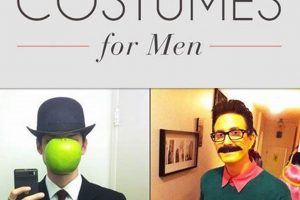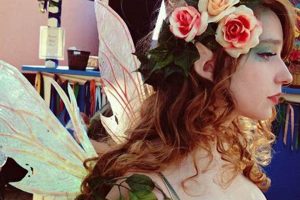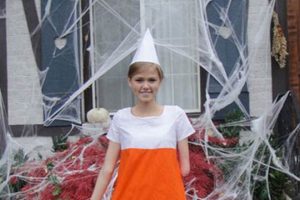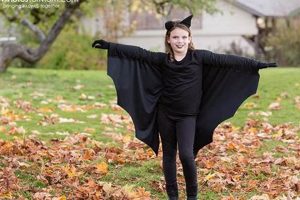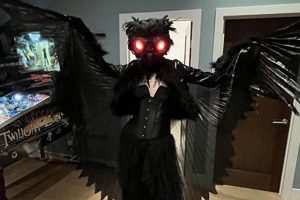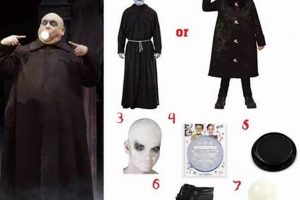Creating a homemade garment inspired by the Marvel character Black Widow involves assembling or crafting attire and accessories that emulate her distinctive look. This typically incorporates elements such as a black jumpsuit, tactical gear, and recognizable emblems, often achieved through repurposed clothing items and readily available craft materials. For example, an individual might modify a black catsuit, add web gear fashioned from belts, and create a replica of the character’s signature wrist gauntlets from foam or other craft materials.
This approach offers significant advantages, including cost-effectiveness, personalization, and creative expression. Individuals can achieve a unique and tailored look, surpassing the uniformity of commercially produced outfits. Historically, self-made costumes have been a staple of fan culture, allowing enthusiasts to engage directly with characters and narratives they admire, fostering a sense of community and individual artistry.
The subsequent sections will delve into specific construction techniques, material selection considerations, and illustrative examples to guide the creation of a visually compelling and accurate representation of the iconic character. Discussion will encompass options for various skill levels and budget constraints, providing a comprehensive resource for crafting an impressive and personalized ensemble.
Crafting a Believable Black Widow Ensemble
Achieving a convincing representation of the Black Widow aesthetic through do-it-yourself methods requires careful attention to detail and a strategic approach to material selection and construction.
Tip 1: Garment Base Selection: Begin with a durable black catsuit or jumpsuit as the foundation. Examine the material composition; a stretchable, matte fabric will offer both comfort and a sleek silhouette. Consider adding reinforcing seams in high-stress areas for increased longevity.
Tip 2: Tactical Gear Replication: Accurately replicate the character’s web gear by utilizing heavy-duty nylon webbing and plastic buckles. Pay close attention to the placement and configuration of pouches and straps, consulting reference images for accuracy. Secure the gear firmly to the base garment to prevent shifting.
Tip 3: Gauntlet Construction: The wrist gauntlets are a key element. Utilize rigid foam or thermoplastic materials for the base structure. Detailing can be achieved through layering craft foam, applying textured paint, and incorporating LED lighting for added visual impact.
Tip 4: Emblem Application: The Black Widow emblem should be accurately reproduced. Employ stencils and fabric paint for a clean, professional look. Alternatively, consider using heat-transfer vinyl for a more durable and precise application.
Tip 5: Hair and Makeup Considerations: Style the hair in a manner consistent with the character’s various appearances. A red wig, carefully styled, is often necessary. Employ subtle, tactical-inspired makeup, focusing on defined eyes and a neutral lip.
Tip 6: Footwear Selection: Choose durable, comfortable boots or tactical footwear in black. These contribute to the overall grounded and practical aesthetic of the character.
Tip 7: Prop Integration: Consider incorporating replicas of the character’s signature weapons, such as batons or pistols. Ensure these props are constructed from lightweight, non-lethal materials and adhere to relevant safety regulations.
Adhering to these guidelines ensures the creation of a visually compelling and credible representation of the character, suitable for costuming events and fan engagement.
The subsequent section will offer a selection of resource materials to aid in the construction process, further refining the ability to create a noteworthy Black Widow inspired garment.
1. Material selection
Material selection is a critical determinant in the successful creation of a Black Widow inspired garment. The chosen materials directly impact the costume’s durability, visual authenticity, comfort, and overall quality. A well-considered selection enhances the believability of the representation and ensures a lasting and wearable product.
- Catsuit Fabric Composition
The primary garment, typically a catsuit or jumpsuit, requires a stretchable, form-fitting fabric. Options include spandex blends, ponte knit, or four-way stretch vinyl. Spandex blends offer comfort and flexibility, while vinyl provides a sleek, leather-like aesthetic. The choice depends on the desired visual effect and wearer preference. Material breathability should also be considered, especially for extended wear.
- Tactical Gear Components
Replicating the character’s tactical gear necessitates durable and functional materials. Nylon webbing, frequently used in real-world military and law enforcement equipment, provides a sturdy base for belts, straps, and pouches. Plastic buckles and closures should be selected for their strength and reliability. The color and texture of these materials significantly contribute to the realism of the costume.
- Gauntlet Construction Materials
The gauntlets, iconic elements of the Black Widow attire, demand rigid materials capable of holding their shape and withstanding wear. Options include EVA foam, thermoplastic sheets (such as Worbla), or 3D-printed components. EVA foam is lightweight and easily shaped but requires sealing and painting for durability. Thermoplastics offer greater strength and detail but necessitate specialized tools and techniques. 3D-printed parts can provide precise replication but require access to a 3D printer and appropriate design skills.
- Embellishment and Detailing
Accurate embellishments and detailing are crucial for achieving a faithful representation. Fabric paints, heat-transfer vinyl, and metal accents can be employed to replicate the character’s emblems and design elements. The selection of these materials should prioritize color accuracy, adhesion, and durability to withstand repeated wear and washing.
The interplay of these material choices profoundly influences the final appearance and functionality of the Black Widow do-it-yourself costume. A strategic and informed approach to material selection is essential for crafting a garment that is both visually striking and enduring, effectively capturing the essence of the character.
2. Pattern adaptation
Pattern adaptation, in the context of a homemade Black Widow garment, represents a critical phase in transforming generic sewing patterns into designs that accurately reflect the character’s distinctive attire. This process extends beyond simple construction, requiring a meticulous adjustment of standard pattern pieces to achieve the desired silhouette, fit, and detailing.
- Jumpsuit Modification for Form-Fitting Silhouette
Standard jumpsuit patterns typically lack the extreme form-fitting nature of the Black Widow catsuit. Adaptation involves reducing seam allowances, incorporating princess seams or darts for enhanced contouring, and potentially using stretch fabrics that necessitate adjustments for negative ease. Examples include modifying existing catsuit patterns or drafting custom patterns based on body measurements to achieve a streamlined, aerodynamic look.
- Integration of Tactical Elements into Base Garment
The addition of tactical elements, such as webbing straps, pouches, and armor plating, requires strategic integration into the base garment pattern. This might involve creating separate pattern pieces for these elements and attaching them to the jumpsuit or modifying the jumpsuit pattern to incorporate integrated attachment points. Considerations include load-bearing capacity, accessibility, and visual accuracy, drawing inspiration from real-world tactical gear designs.
- Adapting Sleeve and Shoulder Construction for Articulation
The Black Widow character frequently engages in dynamic action sequences, demanding a garment that allows for unrestricted movement. Adapting sleeve and shoulder patterns to incorporate gussets or articulated joints can enhance mobility. This involves adding strategically placed fabric inserts or modifying seam lines to provide a greater range of motion without compromising the garment’s overall fit and aesthetic. Examples include raglan sleeve modifications or the addition of underarm gussets.
- Incorporating Design Details from Reference Imagery
Accurate replication of the Black Widow costume necessitates close attention to design details evident in reference images. This includes modifying pattern pieces to incorporate unique seam lines, panel configurations, and decorative elements. Examples include altering necklines, adding decorative topstitching, or incorporating asymmetrical design features based on specific costume iterations.
These pattern adaptations collectively contribute to a more authentic and visually compelling homemade Black Widow garment. The process requires a combination of technical sewing skills, pattern drafting knowledge, and a keen eye for detail, ultimately transforming basic sewing patterns into a credible representation of the iconic character’s attire.
3. Tactical gear accuracy
Achieving a high degree of tactical gear accuracy is paramount in the creation of a credible homemade Black Widow costume. The inclusion of meticulously replicated tactical elements significantly elevates the overall realism and believability of the ensemble, distinguishing it from generic or caricature-like interpretations.
- Webbing and Straps Configuration
The configuration of webbing and straps on the Black Widow’s tactical gear is highly specific and often varies between iterations of the character. Accurately replicating this arrangement requires careful study of reference images and attention to detail in the placement and orientation of each strap. Real-world tactical vests and harnesses provide a useful source of inspiration, offering insights into functional strap arrangements and load-bearing principles. Deviations from accurate configurations can detract from the overall authenticity.
- Pouch and Holster Selection and Placement
The selection and placement of pouches and holsters serve both aesthetic and functional purposes. Each pouch type (e.g., magazine pouch, utility pouch, medical kit) has a distinct design and intended purpose, and their placement on the gear is typically dictated by accessibility and operational efficiency. An accurate representation of the Black Widow’s tactical gear necessitates selecting pouches that closely resemble those used by the character and positioning them in a manner consistent with established tactical protocols. Incorrect pouch selection or placement can create a disjointed and unconvincing appearance.
- Buckle and Fastener Replication
Buckles and fasteners, while seemingly minor details, contribute significantly to the overall realism of the tactical gear. Modern tactical equipment often employs specialized buckles and fasteners designed for rapid deployment and secure retention. Replicating these details requires sourcing accurate replicas of these components or utilizing readily available hardware that closely approximates their appearance and function. Inaccurate buckle and fastener selection can undermine the overall authenticity of the gear.
- Texturing and Weathering Techniques
Real-world tactical gear typically exhibits signs of wear and use, including scuffs, abrasions, and discoloration. Applying texturing and weathering techniques to homemade tactical gear can enhance its realism and convey a sense of operational experience. This can be achieved through the use of dry brushing, washes, and other weathering methods to simulate the effects of wear and tear. Overuse of these techniques, however, can result in an artificial or exaggerated appearance.
The integration of these elements, approached with precision and attention to detail, strengthens the connection between the do-it-yourself Black Widow costume and the character’s established visual representation. Accurate tactical gear, therefore, transcends mere cosmetic enhancement, serving as a critical component in achieving a believable and compelling portrayal.
4. Emblem replication
Emblem replication constitutes a vital aspect of creating a faithful homemade Black Widow costume. The character’s insignia, typically a stylized hourglass or spider symbol, functions as a key identifier, instantly associating the garment with the established persona. Accurate reproduction of this emblem is crucial for achieving a recognizable and authentic representation.
- Stenciling and Painting Techniques
The employment of stenciling and painting techniques offers a cost-effective and readily accessible method for emblem replication. This involves creating a stencil of the desired design, typically from cardstock or acetate, and applying paint to the garment through the stencil openings. Fabric paints are recommended to ensure adhesion and durability. However, the precision achievable through this method is limited by the stencil’s resolution and the application technique. For example, imperfections in stencil cutting or paint bleeding can result in a less-than-perfect emblem. This method is suitable for less complex designs and applications where absolute precision is not paramount.
- Heat Transfer Vinyl Application
Heat transfer vinyl (HTV) provides a more precise and durable alternative to stenciling and painting. This involves cutting the emblem design from HTV using a cutting machine and applying it to the garment with heat and pressure. HTV offers excellent adhesion, crisp edges, and a wide range of colors and finishes. The use of a cutting machine allows for the creation of intricate and highly detailed designs. For instance, complex emblem designs with fine lines and curves can be accurately reproduced using HTV. This method is well-suited for applications requiring a professional and long-lasting finish.
- E
mbroidery and Applique MethodsEmbroidery and applique represent more labor-intensive but potentially higher-quality emblem replication methods. Embroidery involves stitching the emblem design directly onto the garment, either by hand or using an embroidery machine. Applique involves cutting the emblem design from fabric and attaching it to the garment using stitching or adhesive. These methods offer excellent durability and a tactile, three-dimensional effect. Examples include creating raised, textured emblems or incorporating intricate stitching patterns. However, these methods require specialized skills and equipment, and the execution can be time-consuming. They are typically reserved for high-end or custom-made costumes.
- 3D Printing and Attachment
3D printing offers the potential to create highly accurate and detailed emblem replicas, which can then be attached to the costume. This involves designing the emblem in 3D modeling software and printing it using a 3D printer. The printed emblem can then be attached to the garment using adhesive or mechanical fasteners. This method allows for the creation of complex and intricate designs that would be difficult or impossible to achieve using other methods. For instance, emblems with complex curves, fine details, or integrated lighting can be readily created using 3D printing. This method requires access to a 3D printer and familiarity with 3D modeling software.
These approaches to emblem replication collectively highlight the range of options available for achieving a visually compelling and accurate homemade Black Widow costume. The choice of method depends on factors such as budget, skill level, available resources, and desired level of detail and durability. Regardless of the chosen method, accurate emblem replication remains a critical component in capturing the essence of the character’s visual identity.
5. Construction techniques
The creation of a homemade garment inspired by the Black Widow character necessitates a diverse range of construction techniques, each contributing to the final aesthetic and structural integrity of the costume. The selection and proper application of these techniques are directly correlated with the realism and durability of the finished product. Inadequate construction can result in a costume that lacks visual appeal, is uncomfortable to wear, or is prone to damage. For example, poorly executed seams may fail under stress, compromising the structural integrity of the catsuit, while improper attachment of tactical gear elements can detract from the overall authentic appearance. Therefore, understanding and mastering appropriate construction techniques is a crucial prerequisite for a successful project.
Among the essential techniques are pattern modification, garment assembly, tactical gear integration, and embellishment application. Pattern modification, as previously discussed, tailors existing patterns to achieve the desired form-fitting silhouette and accommodate design features specific to the Black Widow character. Garment assembly encompasses sewing techniques applicable to stretch fabrics, including the use of sergers and stretch stitches to ensure seam elasticity and prevent tearing. Tactical gear integration involves secure attachment of webbing, pouches, and other accessories to the base garment, often requiring specialized stitching techniques and the use of reinforcement materials. Embellishment application covers methods for applying emblems, decorative trim, and other detailing elements, ranging from stenciling and fabric painting to heat transfer vinyl application and embroidery. Each of these processes requires a distinct skillset and attention to detail, influencing the final visual impact and longevity of the costume.
In summary, proficient application of appropriate construction techniques is indispensable to the realization of a credible and durable Black Widow inspired garment. The quality of the seams, the security of tactical attachments, and the precision of emblem application are all direct outcomes of skillful construction. While aesthetic considerations are important, the underlying construction is what ultimately determines the usability and longevity of the final product. Overlooking the importance of these techniques can undermine the entire project, resulting in a costume that fails to meet expectations and is ultimately unsuitable for its intended purpose.
6. Character portrayal
Character portrayal, in the context of a homemade Black Widow garment, extends beyond mere visual imitation. It encompasses the successful conveyance of the character’s inherent qualities through the costume’s design and execution. The effectiveness of a “black widow diy costume” hinges significantly on how well it captures the essence of Black Widows persona, thereby influencing the audience’s perception and the wearer’s own sense of embodying the role. A poorly executed garment, despite superficial resemblance, can fail to evoke the intended character, diminishing the impact of the overall effort. For instance, a catsuit constructed from cheap, ill-fitting material and adorned with inaccurate tactical gear will likely convey a lack of authenticity, hindering the character portrayal. Conversely, a meticulously crafted costume, incorporating appropriate materials, precise detailing, and a thoughtful consideration of the character’s physicality, enhances the portrayal, allowing for a more immersive and convincing representation.
The connection between costume and portrayal manifests practically in various aspects of the creation process. The choice of fabric, for example, influences not only the costume’s visual appearance but also its functionality and comfort, thereby impacting the wearer’s ability to embody the character effectively. The strategic placement of tactical gear and the accuracy of emblem reproduction further contribute to the portrayal by reinforcing the character’s background and capabilities. Real-world examples illustrate this point: a cosplayer who invests in high-quality materials and meticulously replicates the costume’s details is more likely to achieve a compelling portrayal than someone who prioritizes cost-cutting over accuracy. Similarly, understanding the character’s movements and mannerisms informs the costume’s design, ensuring that it allows for the necessary range of motion and aligns with the character’s overall aesthetic.
In conclusion, character portrayal is not merely an aesthetic consideration; it is an integral component of a successful “black widow diy costume.” The connection between the garment’s design and the character’s essence influences the audience’s perception and the wearer’s ability to embody the role. While the creation of a visually accurate costume presents technical challenges, a thoughtful consideration of character portrayal elevates the project from a simple imitation to a more meaningful and engaging representation. This underscores the importance of investing in quality materials, meticulous detailing, and a thorough understanding of the character’s persona, ensuring that the final product effectively conveys the intended message and resonates with its audience.
Frequently Asked Questions
This section addresses common inquiries regarding the creation of a homemade garment inspired by the Black Widow character. The following questions and answers provide guidance on various aspects of the project, from material selec
tion to construction techniques.
Question 1: What is the most suitable fabric for replicating the catsuit?
The selection of catsuit fabric should prioritize both aesthetic accuracy and wearer comfort. Spandex blends offer a balance of stretch, form-fitting properties, and breathability. Alternative options include four-way stretch vinyl for a leather-like appearance, though this may compromise comfort during extended wear. The specific choice should consider the wearer’s sensitivity to different fabric textures and the intended use case, such as attending a convention or participating in a photoshoot.
Question 2: How can tactical gear be effectively integrated into the costume?
Effective integration of tactical gear requires careful planning and secure attachment methods. Options include sewing webbing directly onto the base garment, utilizing modular attachment systems (e.g., MOLLE), or constructing a separate harness system that can be worn over the catsuit. The chosen method should ensure that the gear remains securely in place during movement and does not impede the wearer’s range of motion.
Question 3: What are the best techniques for emblem replication?
Emblem replication can be achieved through various methods, each with its own advantages and disadvantages. Heat transfer vinyl provides a precise and durable option for intricate designs. Stenciling and fabric painting offer a cost-effective alternative for simpler emblems. Embroidery, whether done by hand or machine, yields a textured and professional-looking result. The chosen technique should align with the complexity of the emblem design and the available resources.
Question 4: How can gauntlets be constructed to resemble the character’s signature wrist devices?
Gauntlet construction typically involves creating a rigid base from materials such as EVA foam, thermoplastic, or 3D-printed components. Detailing can be achieved through layering craft foam, applying textured paint, and incorporating LED lighting for added visual impact. The design should accurately reflect the character’s gauntlets as depicted in reference materials, paying attention to shape, size, and functionality.
Question 5: What footwear options are appropriate for completing the costume?
Appropriate footwear options include black boots or tactical-style footwear. The selection should prioritize comfort, durability, and aesthetic consistency with the character’s overall appearance. High-heeled boots may enhance the visual impact but could compromise comfort during extended wear. Tactical boots offer a more practical and grounded aesthetic, aligning with the character’s combat-oriented background.
Question 6: How can cost be effectively managed during the construction process?
Cost-effective construction requires strategic material sourcing and resourcefulness. Repurposing existing clothing items can reduce the need for purchasing new fabrics. Utilizing readily available craft materials, such as foam and plastic, can lower the cost of constructing tactical gear and accessories. Comparing prices from different suppliers and taking advantage of sales or discounts can further minimize expenses.
These FAQs provide a foundation for navigating the challenges and opportunities associated with creating a homemade garment inspired by the Black Widow character. Careful planning, attention to detail, and a willingness to experiment are key to achieving a successful outcome.
The subsequent section will delve into advanced techniques and considerations for achieving a professional-grade finish, further refining the ability to create a noteworthy Black Widow inspired garment.
Conclusion
This exposition has thoroughly examined the multifaceted considerations involved in crafting a “black widow diy costume”. The exploration encompassed critical aspects such as strategic material selection, precision pattern adaptation, meticulous tactical gear replication, accurate emblem reproduction, appropriate construction techniques, and nuanced character portrayal. Each element contributes significantly to the overall realism and effectiveness of the final garment.
The pursuit of a compelling and authentic representation demands a commitment to detail and a comprehensive understanding of the character’s visual identity. As enthusiasts continue to engage with this creative endeavor, the potential for innovation and refinement in the creation of homemade attire remains substantial, underscoring the enduring appeal of the character and the boundless possibilities of do-it-yourself craftsmanship.


